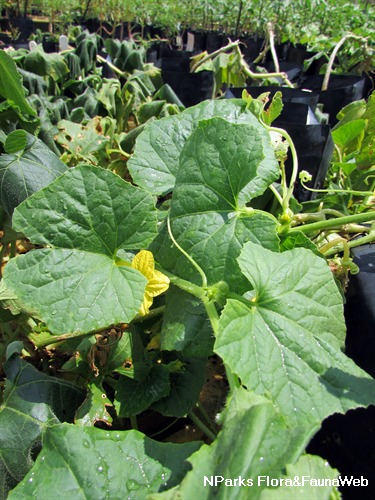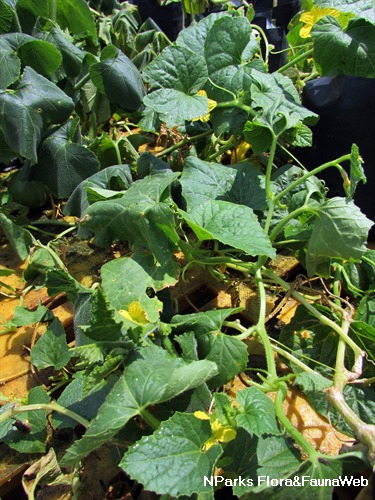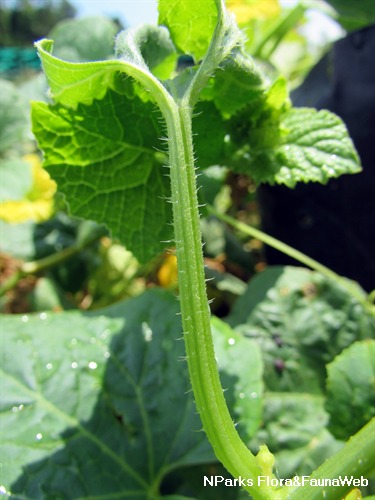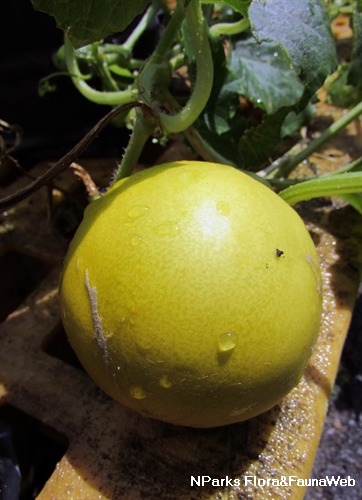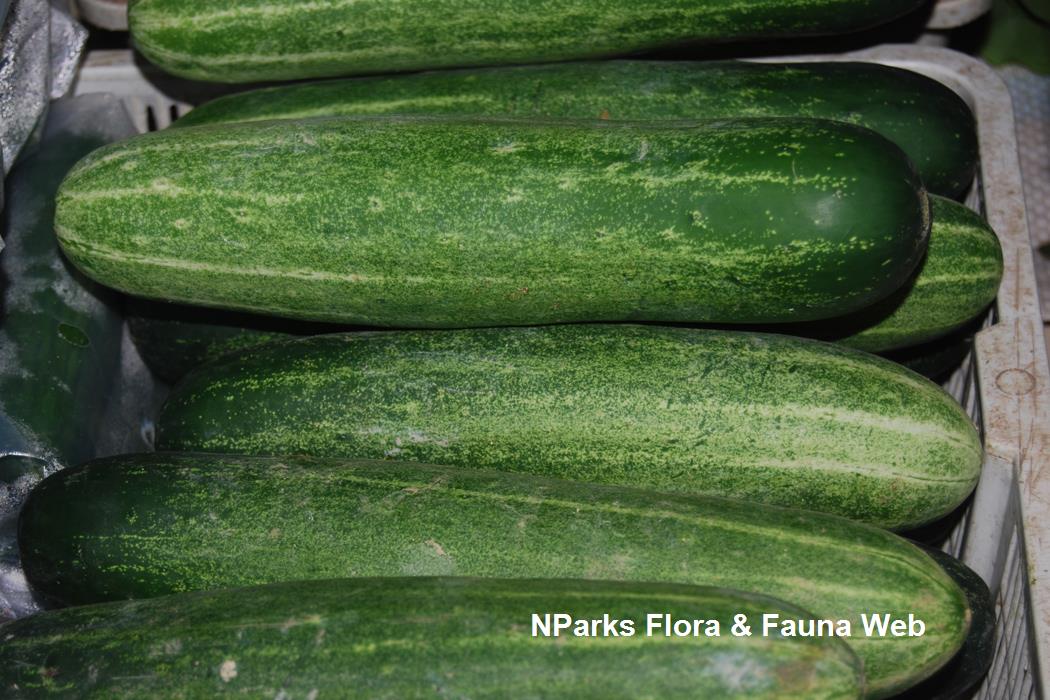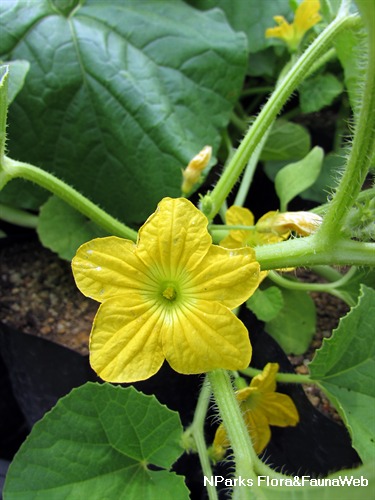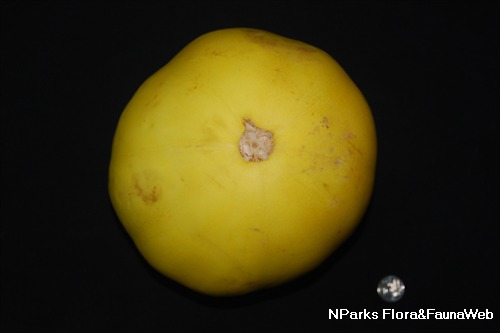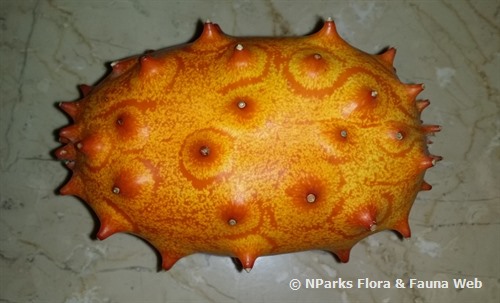
Back
Cucumis melo L.
| Family Name: | Cucurbitaceae |
| Synonyms: | Cucumis acidus |
| Common Name: | Melon, Muskmelon, 甜瓜 |
Name
Classifications and Characteristics
| Plant Division | Angiosperms (Flowering Seed Plants) (Dicotyledon) |
|---|---|
| Plant Growth Form | Climber |
| Lifespan (in Singapore) | Annual |
| Mode of Nutrition | Autotrophic |
| Maximum Height | 3 m |
Description and Ethnobotany
| Growth Form | Vine with a creeping or trailing growth habit. |
|---|---|
| Foliage | Leaves are bean-shaped to approximately round with prominent veins (6-15 cm long, 6-15 cm wide). The leaf margin is lined with pointed teeth. |
| Stems | Stems are round or ridged and covered in long, white hairs. |
| Flowers | Plants may produce male and female flowers on the same plant (monoecious) or bisexual flowers. Male flowers are solitary or occur in small clusters, while female flowers are solitary. Bright yellow flowers are composed of 5 egg-shaped to oval, wrinkled petals. The longitudinal veins on the petals are prominent. |
| Fruit | Fruits vary widely in size, shape, texture and taste. It contains numerous yellowish white seeds which are ovate to oblong (4-8 mm long, 2.4-4 mm wide). |
| Associated Fauna | Cucmis melo is mainly pollinated by bees, but it can also self-pollinate. |
| Cultivation | It grows best in sandy loam soils with pH 6 to 6.5. The roots are sensitive to disturbance, so it is better to directly seed the soil or use biodegradable containers for seedlings to be transplanted. |
| Etymology | The genus 'Cucumis' means cucumber in Latin, while the specific epithet 'melo' is an abbreviation of melopepo, meaning an apple-shaped melon. |
| Ethnobotanical Uses | Edible Plant Parts : Edible Fruits Food (Fruit or Vegetable): The species was bred to produce many cultivars of melon, including the popular honeydew and cantaloupe, as well as non-sweet varieties that are used as vegetables. |
Landscaping Features
| Thematic Landscaping | Economic Garden |
|---|
Plant Care and Propagation
| Light Preference | Full Sun |
|---|---|
| Water Preference | Moderate Water |
| Rootzone Tolerance | Well-Drained Soils, Fertile Loamy Soils |
Foliar
| Mature Foliage Colour(s) | Green |
|---|---|
| Mature Foliage Texture(s) | Velvety / Furry / Tomentose |
| Prominent Young Flush Colour(s) | Green |
| Young Flush Texture(s) | Velvety / Furry / Tomentose |
| Foliar Modification | Foliar Tendril |
| Foliar Type | Simple / Unifoliate |
| Foliar Arrangement Along Stem | Alternate |
| Foliar Attachment to Stem | Petiolate |
| Foliar Shape(s) | Non-Palm Foliage (Orbicular / Round, Reniform) |
| Foliar Venation | Palmate |
| Foliar Margin | Dentate |
| Foliar Apex - Tip | Acute, Rounded |
| Foliar Base | Cordate |
Floral (Angiosperm)
| Flower & Plant Sexuality | Unisexual & Bisexual Flowers(Sub-dioecious) |
| Flower Colour(s) | Yellow / Golden |
|---|---|
| Flower Texture(s) | Wrinkled |
| Flower Grouping | Solitary |
| Flower Location | Axillary |
| Flower Symmetry | Radial |
Fruit, Seed and Spore
| Mature Fruit Colour(s) | Cream / Off-White, Green - Light Green, Yellow / Golden |
|---|---|
| Mature Fruit Texture(s) | Smooth, Rough, [Remarks] (It varies widely from smooth in honeydew to netted in cantaloupe.) |
| Fruit Classification | Simple Fruit |
| Fruit Type | |
| Mature Seed Colour(s) | Cream / Off-White |
| Mature Seed Texture(s) | Smooth |
| Seed Quantity Per Fruit | Numerous (>20) |
Image Repository
Others
| Master ID | 32255 |
|---|---|
| Species ID | 6663 |
| Flora Disclaimer | The information in this website has been compiled from reliable sources, such as reference works on medicinal plants. It is not a substitute for medical advice or treatment and NParks does not purport to provide any medical advice. Readers should always consult his/her physician before using or consuming a plant for medicinal purposes. |

